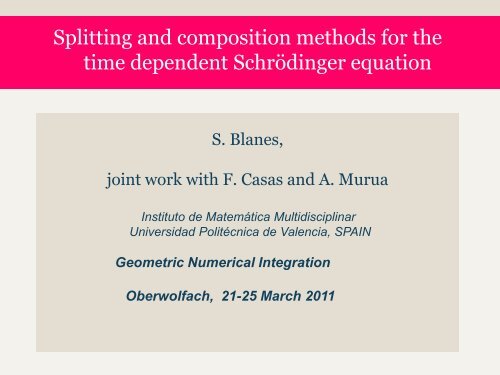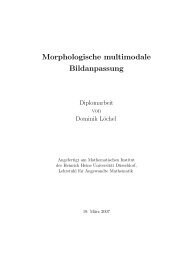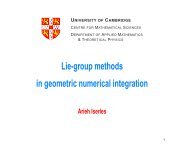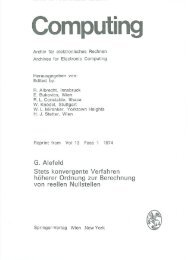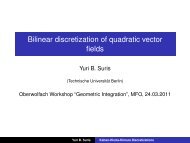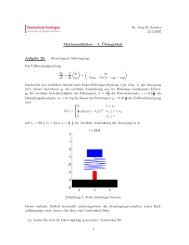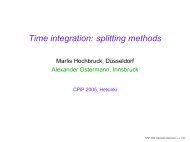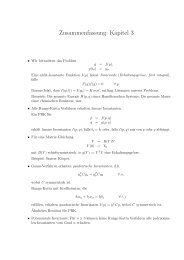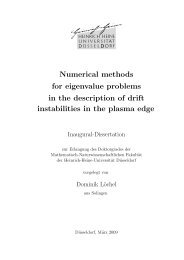The Symplectic Splitting Method
The Symplectic Splitting Method
The Symplectic Splitting Method
You also want an ePaper? Increase the reach of your titles
YUMPU automatically turns print PDFs into web optimized ePapers that Google loves.
<strong>Splitting</strong> and composition methods for the<br />
time dependent Schrödinger equation<br />
S. Blanes,<br />
joint work with F. Casas and A. Murua<br />
Instituto de Matemática Multidisciplinar<br />
Universidad Politécnica de Valencia, SPAIN<br />
Geometric Numerical Integration<br />
Oberwolfach, 21-25 March 2011
<strong>The</strong> Schrödinger equation<br />
We consider different families of Geometric Integrators for solving the SE<br />
<strong>The</strong> solution of the discretised autonomous equation is given by<br />
where c = (c 1,…, c N) T C N and H = T + V R N×N Hermitian matrix.<br />
Fourier methods are frequently used<br />
is the fast Fourier transform (FFT)
<strong>The</strong> <strong>Method</strong>s Considered<br />
I - If the solution is not smooth: methods which involve products H c<br />
Polynomial approximations to the action of the exponential on a vector<br />
1 – Taylor<br />
2 – Chebyshev<br />
II - If the solution is smooth: to split H=T+V<br />
3 – <strong>Splitting</strong> (real + imaginary parts)<br />
High-order <strong>Splitting</strong>-decomposition methods (with possible complex<br />
coefficients)
<strong>The</strong> <strong>Method</strong>s Considered<br />
I - If the solution is not smooth: methods which involve products H c<br />
Polynomial approximations to the action of the exponential on a vector<br />
1 – Taylor<br />
2 – Chebyshev<br />
3 – <strong>Splitting</strong> (real + imaginary parts)
<strong>The</strong> <strong>Method</strong>s Considered<br />
I - If the solution is not smooth: methods which involve products H c<br />
Polynomial approximations to the action of the exponential on a vector<br />
1 – Taylor<br />
2 – Chebyshev<br />
3 – <strong>Splitting</strong> (real + imaginary parts)<br />
If we consider the following problems are equivalent<br />
or, in short: z’ = M z with z = (q,p) T
<strong>The</strong> Taylor <strong>Method</strong><br />
An m-stage Taylor method to approximate<br />
where is the Taylor expansion of the exponential, which<br />
approximates the exact solution up to order m
<strong>The</strong> Taylor <strong>Method</strong><br />
An m-stage Taylor method to approximate<br />
where is the Taylor expansion of the exponential, which<br />
approximates the exact solution up to order m<br />
We can advance each step by using the Horner's algorithm<br />
This algorithm can be trivially rewritten in terms of the real vectors, and it<br />
only requires to store two extra complex vectors (four real vectors).
<strong>The</strong> matrix that propagates the numerical solution can be written as<br />
where the entries T1(y) and T2(y) are the Taylor series expansion of cos(y)<br />
and sin(y) up to order m, i.e.<br />
Notice that<br />
<strong>The</strong> eigenvalues are given by<br />
<strong>The</strong> scheme is stable if<br />
<strong>The</strong> Taylor <strong>Method</strong><br />
For practical purposes, we require however
<strong>The</strong> Chebyshev <strong>Method</strong><br />
<strong>The</strong> Chebyshev method approximates the action of the exponential on the<br />
initial conditions by a near-optimal polynomial given by:<br />
where<br />
with Here, Tk(x) is the kth Chebyshev polynomial<br />
generated from the recursion<br />
and T0(x)=1, T1(x)=x. Jk(w) are the Bessel functions of the first kind which<br />
provides a superlinear convergence for m > t r(H ) i.e.
<strong>The</strong> Clenshaw algorithm allows to compute the action of the polynomial by<br />
storing only three vectors<br />
which can also be easily rewritten in term of the real vectors and it only<br />
requires to store six real vectors. <strong>The</strong> scheme can be written as<br />
As in the Taylor case:<br />
It is not a symplectic transformation.<br />
<strong>The</strong> Chebyshev <strong>Method</strong>
Taylor order tol=inf tol=10 -8 tol=10 -4<br />
10. 0. 0. 0.<br />
15. 0.111249 0.111249 0.111249<br />
20. 0.164515 0.164515 0.164515<br />
25. 0. 0.065246 0.065246<br />
30. 0. 0.108088 0.108088<br />
35. 0.0461259 0.138361 0.322661<br />
40. 0.0804521 0.160884 0.321618<br />
45. 0. 0.178294 0.320804<br />
50. 0. 0.192154 0.32015<br />
Chebyshev order tol=inf tol=10 -8 tol=10 -4<br />
20. 0.00362818 0.321723 0.643217<br />
25. 0.00233368 0.384289 0.64029<br />
30. 0.00162599 0.425648 0.638324<br />
35. 0.00119743 0.45502 0.636912<br />
40. 0.000918402 0.476957 0.63585<br />
45. 0.000726646 0.635021 0.635021<br />
50. 0.000589228 0.634356 0.634356<br />
55. 0. 0.633812 0.633812<br />
60. 0. 0.633357 0.633357
<strong>The</strong> <strong>Symplectic</strong> <strong>Splitting</strong> <strong>Method</strong><br />
Taylor and Chebyshev methods consider vector-matrix products to<br />
approximate<br />
A first order approximation<br />
can be written with<br />
or
<strong>The</strong> linear time dependent SE<br />
with H real and can be reformulated using real variables as the<br />
Hamiltonian system:<br />
with formal solution:<br />
<strong>The</strong> <strong>Symplectic</strong> <strong>Splitting</strong> <strong>Method</strong>
We have built splitting methods for the harmonic oscillator!!!<br />
<strong>Splitting</strong> method<br />
We have<br />
<strong>The</strong> <strong>Symplectic</strong> <strong>Splitting</strong> <strong>Method</strong><br />
which are polynomials of degree twice higher as in the previous cases for<br />
the same number of stages.
<strong>The</strong> <strong>Symplectic</strong> <strong>Splitting</strong> <strong>Method</strong><br />
<strong>The</strong> algorithm: a generalisation of the Horner's algorithm or the<br />
Clenshav algorithm<br />
It only requires to store one additional real vector of dimension<br />
<strong>The</strong> methods preserve symplecticity by construction:<br />
Stability: M is stable if |Tr K|
<strong>The</strong>orem: Any composition method is conjugate to an orthogonal method,<br />
and unitarity is preserved up to conjugacy.<br />
<strong>The</strong>re is a recursive procedure to get the coefficients of the splitting<br />
methods from the coefficients of the matrix K.<br />
We can build different matrices with:<br />
- Large stability domain<br />
<strong>The</strong> <strong>Symplectic</strong> <strong>Splitting</strong> <strong>Method</strong><br />
- Accurate approximation to the solution in the whole interval (like<br />
Chebyshev)<br />
- <strong>Method</strong>s with different orders of accuracy and very large number of<br />
satges.
Error bounds:<br />
<strong>Splitting</strong> <strong>Method</strong>s: valid for
with<br />
Initial conditions<br />
Schrödinger equation with a Poschl-Teller potential
LOG(ERROR)<br />
0<br />
-2<br />
-4<br />
-6<br />
-8<br />
-10<br />
-12<br />
Poschl-Teller potential<br />
Taylor: 10-40<br />
-14<br />
3.1 3.2 3.3 3.4 3.5 3.6 3.7 3.8 3.9 4 4.1<br />
LOG(FFT CALLS)
LOG(ERROR)<br />
0<br />
-2<br />
-4<br />
-6<br />
-8<br />
-10<br />
-12<br />
Poschl-Teller potential<br />
Split: 4-12<br />
-14<br />
3.1 3.2 3.3 3.4 3.5 3.6 3.7 3.8 3.9 4 4.1<br />
LOG(FFT CALLS)
LOG(ERROR)<br />
0<br />
-2<br />
-4<br />
-6<br />
-8<br />
-10<br />
-12<br />
Poschl-Teller potential<br />
Chebyshev: 20-100<br />
-14<br />
3.1 3.2 3.3 3.4 3.5 3.6 3.7 3.8 3.9 4 4.1<br />
LOG(FFT CALLS)
LOG(ERROR)<br />
0<br />
-2<br />
-4<br />
-6<br />
-8<br />
-10<br />
-12<br />
Poschl-Teller potential<br />
New Split<br />
-14<br />
3.1 3.2 3.3 3.4 3.5 3.6 3.7 3.8 3.9 4 4.1<br />
LOG(FFT CALLS)
References<br />
SB, F. Casas, and A. Murua, Work in Progress.<br />
Group webpage: http://www.gicas.uji.es<br />
SB, F. Casas and A. Murua, <strong>Symplectic</strong> splitting operator methods for the<br />
time-dependent Schrödinger equation, J. Chem. Phys. 124 (2006)<br />
234105.<br />
SB, F. Casas and A. Murua, On the linear stabylity of splitting methods,<br />
Found. Comp. Math., 8 (2008), 357-393.<br />
SB, F. Casas and A. Murua, Error analysis of splitting methods for the<br />
time-dependent Schrödinger equation, Submitted.
<strong>The</strong> Schrödinger equation<br />
II - If the solution is smooth: to split H=T+V<br />
High-order <strong>Splitting</strong> methods<br />
but the computation using FFTs is:<br />
<strong>The</strong> computational cost is independent if the coeficients are real<br />
or complex but, the coefficnets a i must be real because D T is an<br />
unbounded operator.
<strong>Splitting</strong> methods with complex coefficients
<strong>Splitting</strong> methods with complex coefficients
<strong>Splitting</strong> methods with complex coefficients<br />
SB, Casas, Chartier, and Murua, <strong>Splitting</strong> methods with complex coefficients for<br />
some classes of evolution equations. Submitted. arXiv:1102.1622v1
LOG(ERROR)<br />
-1<br />
-2<br />
-3<br />
-4<br />
-5<br />
-6<br />
-7<br />
-8<br />
A simple example: the Lotka-Volterra problem<br />
-9<br />
3.8 4 4.2 4.4 4.6 4.8 5 5.2<br />
LOG(EVALUATIONS)<br />
S 7 6R<br />
S 7 6C<br />
4 S 7 6C
<strong>Splitting</strong> for perturbed systems<br />
Additional benefits of the unitary splitting: It allows different ways to splitt<br />
depending on the structure of the problem
<strong>Splitting</strong> for perturbed systems<br />
Additional benefits of the unitary splitting: It allows different ways to splitt<br />
depending on the structure of the problem
<strong>Splitting</strong> for perturbed systems<br />
Additional benefits of the unitary splitting: It allows different ways to splitt<br />
depending on the structure of the problem<br />
This result can be generalised to the explicitly time-dependent case:<br />
P. Bader and SB, Fourier methods for the perturbed harmonic oscillator in linear<br />
and nonlinear Schrödinger equations. Phys Rev. E. In press.
Conclusions<br />
<strong>Splitting</strong> methods are powerful tools for numerically solving the<br />
Schrödinger equation<br />
Some a priori knowledge of the problem and its solution is essential<br />
for an efficient integration<br />
<strong>The</strong> performance strongly depends on how the system has been<br />
split as well as on the choice of the appropriate method for each<br />
problem<br />
<strong>Splitting</strong> methods with complex coefficients could lead to very<br />
efficient methods for many problems


